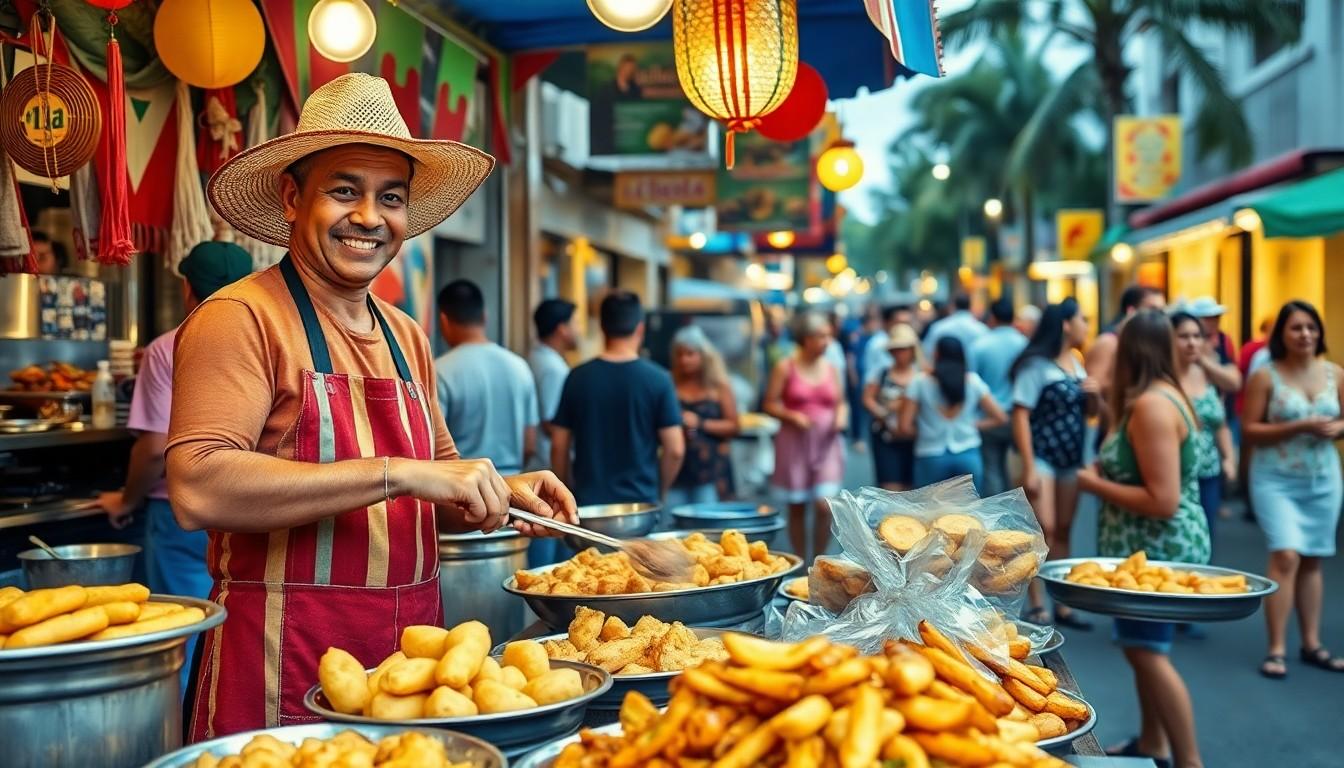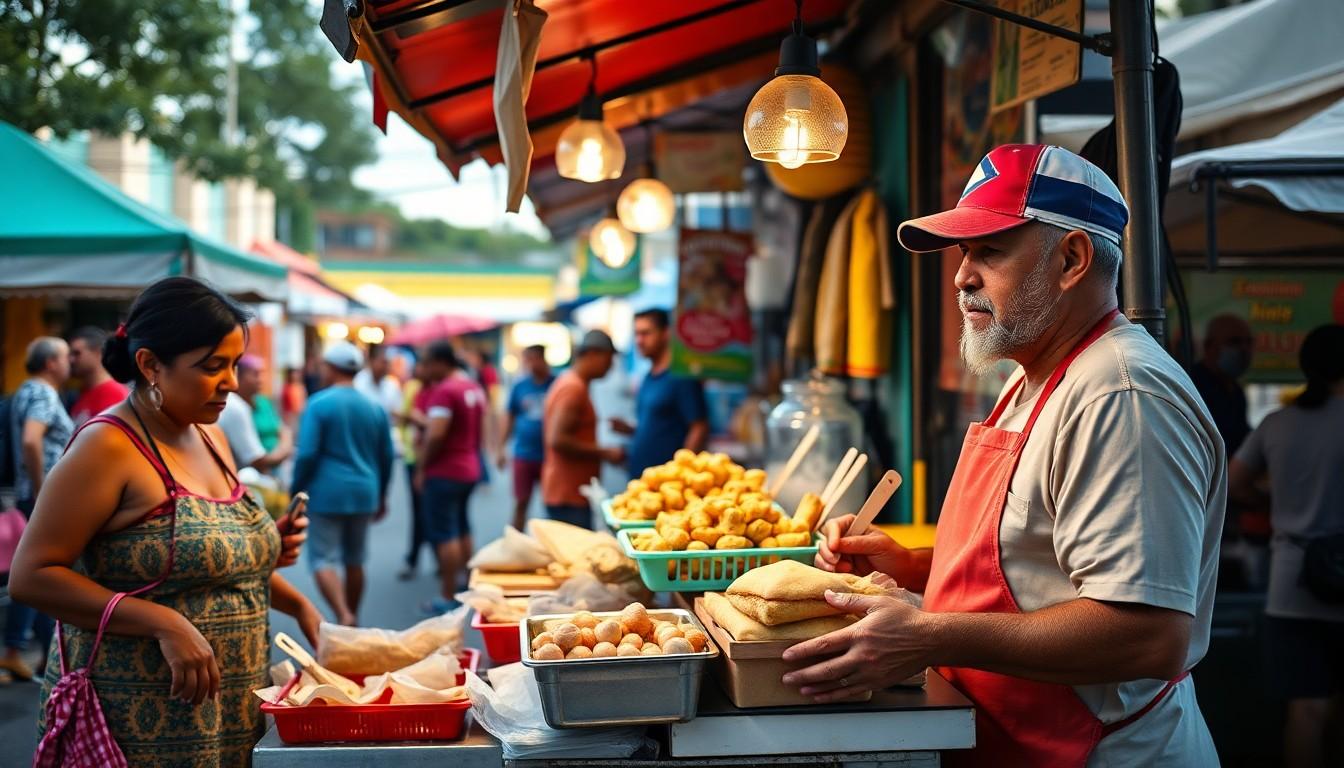Physical Address
304 North Cardinal St.
Dorchester Center, MA 02124

When it comes to street food, Puerto Rico serves up a fiesta for the taste buds that’s hard to resist. Imagine wandering through vibrant streets filled with the irresistible aroma of sizzling meats, crispy snacks, and sweet treats that’ll make you wonder how you ever lived without them. From the legendary alcapurrias to the mouthwatering bacalaitos, every bite tells a story of culture and tradition.
Puerto Rican street food embodies a fusion of native Taino, Spanish, and African influences. Local vendors serve delicious offerings that showcase the island’s culinary heritage. Notable dishes include alcapurrias, which are fried fritters filled with meat. Bacalaitos, crispy codfish fritters, also capture the attention of passersby.
Each vendor often adds their unique twist to traditional recipes, enhancing flavor and presentation. Street food reflects the vibrant culture of Puerto Rico, offering locals and tourists alike an authentic taste of island life.
Common ingredients highlight the use of fresh produce, seafood, and spices. Plantains appear frequently in dishes, serving as a staple food. Pastellón, a savory pie made from layers of plantains and ground meat, remains a favorite.
In bustling markets and street corners, the visual appeal of food stalls draws in crowds. The aroma of grilling meats and frying pastries creates an inviting atmosphere. Street food in Puerto Rico provides both accessibility and affordability, making it a popular choice among residents.
Culinary festivals often showcase local street food vendors, emphasizing their creativity. The sense of community flourishes in these gatherings, where food becomes a shared experience. Enjoying meals on the go captures the essence of Puerto Rican life, reflecting the joy of discovering new flavors.

Puerto Rican street food offers a variety of flavors and textures, providing a unique culinary experience. Several dishes have achieved popularity among locals and visitors alike.
Alcapurrias stand out as a beloved snack, often made from green plantain or yuca. Vendors fill these fritters with savory meats like beef, chicken, or crab. Once prepared, they fry them to a crispy finish, offering a delightful contrast between the tender interior and the crunchy exterior. Many people enjoy alcapurrias on the go, making them a convenient street food choice. Each vendor’s recipe adds a personal touch, enhancing the depth of flavor and texture.
Bacalaitos deliver a satisfying seafood experience, with their crispy texture and rich taste. Fried codfish fritters play a significant role in Puerto Rican cuisine. Vendors often serve bacalaitos hot and golden brown, enjoyed for their saltiness and crunch. A spritz of lime can elevate the flavor even further. Many visitors seek these treats at festivals, where they become instant hits among seafood lovers, showcasing the island’s culinary creativity.
Empanadillas present a delightful option for those craving portable comfort food. Stuffed with various fillings, including beef, chicken, or cheese, these pastries capture the essence of Puerto Rican flavors. Chefs prepare empanadillas by folding dough over filling and frying or baking until golden. Each bite offers a burst of savory goodness. Street vendors often showcase their unique versions, turning empanadillas into a canvas for culinary innovation, enjoyed by all who encounter them.
Puerto Rican street food reflects the island’s vibrant culture and its unique culinary identity. Each dish represents a rich blend of history and local traditions.
Historical influences play a crucial role in shaping Puerto Rican street food. The Taino’s agricultural practices laid the foundation for indigenous recipes. Spanish colonization introduced new ingredients like olives and meats. African traditions contributed to cooking techniques and flavor profiles. Together, these influences created a diverse culinary scene, showcasing the island’s adaptability and creativity. By sampling street food, one gains insight into Puerto Rico’s multicultural heritage.
Local ingredients form the backbone of Puerto Rican street food. Fresh produce, seafood, and spices dominate the culinary landscape. Plantains consistently appear across various dishes, serving as a versatile staple. Seafood, especially fish, thrives along the coasts, ensuring flavorful offerings. Spices and herbs add depth, elevating simple ingredients into memorable meals. Vendors often emphasize quality by sourcing from local markets. The use of these ingredients highlights the connection between Puerto Rican cuisine and its environment, fostering a sense of pride in local flavors.
Exploring Puerto Rican street food offers a delightful experience, allowing visitors to encounter traditional flavors through various avenues. Street vendors and food festivals are two popular ways to savor local culinary offerings.
Street vendors populate neighborhoods, especially in urban areas like San Juan. Brightly colored carts and stalls catch the eye, often showcasing enticing menus. They serve classic dishes such as alcapurrias, bacalaitos, and empanadillas, each with distinctive flavors influenced by local ingredients. Many vendors add personal touches to their recipes, creating unique variations that reflect their culinary styles. Engaging with these vendors provides insights into the rich culture behind each dish, making each interaction authentic and memorable.
Food festivals showcase the vibrant street food scene across Puerto Rico. Annual events, like the San Juan Culinary Festival, feature numerous booths and food trucks. Visitors enjoy sampling a variety of offerings, from traditional dishes to innovative bites. The lively atmosphere generates a sense of community as locals and tourists come together to celebrate Puerto Rican cuisine. Notable chefs and local artisans often participate, highlighting the island’s diverse culinary talent and creativity. These festivals serve as prime opportunities to immerse in the island’s flavors, culture, and traditions.
Puerto Rican street food is more than just a meal; it’s an experience that connects people to the island’s rich heritage. Each dish tells a story of cultural fusion and community spirit that thrives in the vibrant streets. From the crispy alcapurrias to the flavorful bacalaitos, every bite offers a taste of tradition and innovation.
Exploring the local food scene allows visitors to appreciate the creativity of street vendors who pour their passion into every dish. The accessibility and affordability of these offerings make them a staple in everyday life. Whether at a bustling market or a lively festival, the joy of Puerto Rican street food is undeniable and invites everyone to savor the flavors of the island.